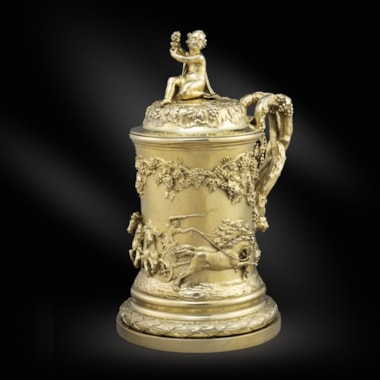The candelabrum with concave triform base raised on three ball feet, engraved with presentation inscription:
'To Hardinge Stracey Esq -The Light Horse Volunteers - of London and Westminster - Voted at a general meeting of the Corps 5th June 1805. - on his retiring from the Majority of their Regiment - in Testimony of their lasting Esteem and in grateful acknowledgement of his services'.
The base supporting three cast lions couchant, each holding a shield bearing the arms of the City of Westminster, the arms of the City of London and the badge of the Light Horse Volunteers respectively.
The detachable acanthus-wrapped branches issuing from a circular central sconce raised on three square fluted columns terminating in claw feet and hung with lion pelts.
Major Hardinge Stracey is recorded as commandant of the London and Westminster Light Horse Volunteers in 1804.
The partnership of Digby Scott and Benjamin Smith produced some of the greatest silver works of the early 19th century. Scott and Smith jointly ran workshops located in Greenwich, England from 1802 to 1807 and during their brief partnership were the principal suppliers of silver masterpieces to the esteemed firm of Rundell, Bridge & Rundell. At the time London's most prestigious firm, these jewellers and silversmiths supplied the official plate ordered by the Lord Chamberlain's office, and were the official "Jeweller, Gold and Silversmiths to the Crown" from 1798 to 1843. Working in the cusp of the late Georgian and early Regency periods, the works of Scott and Smith often feature elements of the classical revival style such as grapevines and rams' heads, all crafted in exquisite, sumptuous detail. One of their most renowned collaborative efforts, the Duke of York Baskets, created for Frederick Augustus (1763-1827), second son of George III, is currently on display at the Powerhouse Museum in Australia.
You May Also Like








































































